Sukkot is a Jewish holiday known as the Feast of Booths, or Feast of Tabernacles. With this holiday comes a long weekend--including a day off of work on Thursday preceeded by another "early release" (the shuttle buses left work at 1pm) on Wednesday.
We utilized our free Thursday to visit Nazareth, the hometown of the young Jesus. And on the way, we stopped off at Megiddo, a fascinating archaelogical site with some sobering events prophesied to take place there in the future.
Back to Sukkot. As one of the appointed festivals mentioned in Leviticus, the Lord, via Moses, asked the Israelites to live in "booths" in remembrance to what He'd done for them during the Exodus from Egypt. Here is the reference from Leviticus 23:42-43...
"Live in temporary shelters for seven days: All native-born Israelites are to live in such shelters so your descendants will know that I had the Israelites live in temporary shelters when I brought them out of Egypt. I am the LORD your God."
To this day, obsevant Jews are still building, eating in, and even sleeping in these booths known as "sukkahs" during Sukkot. In fact we've seen them all over town. Here's one we saw at Megiddo:
And here's another sukkah near the beach in our neighborhood.
The trip to Tel Megiddo was a short one--it's about an hour drive northeast from our apartment in Tel Aviv. "Tel" means hill, and seems to also refer to sites at which there are several layers of archaelogical interest. In this case, the tel has 26 layers of ruins! "Megiddo" is a hill overlooking the Valley of Jezreel, and is the site of thousands of years of history.
Situated in an apparently strategic location along an ancient trade route between Egypt and Syria, the city of Megiddo has seen its share of turbulence. The town changed hands many times over the millenia, being controlled by, but not limited to, the Egyptians, Canaanites, Assyrians, Turks, Romans, Palenstinians, and even the British. Megiddo has also witnessed its share of battles--including one in which King Josiah was killed (see 2 Kings 23:29). Gideon, with God's help, conquered the Midianites here (Judges 6:33). And King Saul was killed on nearby Mount Gilboa (1 Samuel 31:8). More recently, if you can call 1918 recent, British General Allenby defeated the Ottoman Turks for control of Palestine during World War I. Now I understand why there is an Allenby street in Tel Aviv.
Looking forward, Megiddo may very well host another battle--the battle of all battles, in fact. John, in the book of Revelation, says the following:
Revelation 16:16: "Then they gathered the kings together to the place that in Hebrew is called Armageddon"
Apparently the Greek word "Armageddon" is likely derived from the Hebrew Har Megiddo, which is Mount of Megiddo. Thus, many Biblical scholars believe that the Battle of Armageddon may take place right here at Megiddo! Yikes, just an hour from where we are living.
Here's a view of the Jezreel Valley from Megiddo. That's Mount Tabor in the background.
Here is a beautiful woman that I spotted at Megiddo. She was carrying a pretty cute kid, too!
Here's another view of Megiddo with Mount Tabor looming in the background.
This is a nearby field. The air at Megiddo smelled so pleasant that we tried to figure out where the aroma was coming from. Perhaps from this field? The birds sure seemed to like whatever was growing here...
One of the most unique and interesting aspects of Megiddo was its water system. While the city's location atop a hill was strategic militarily, it posed a problem in that the city's two water sources were located outside of the city walls. Prior to ~850 BC, residents had to go outside the walls to fetch water. But, King Ahab changed all of that, constructing a shaft & tunnel system which enabled residents of Megiddo to access water without exiting the city walls!
Here's a picture of the warning sign next to the stairway down to Ahab's shaft.
This sign filled us in on the details of the shaft and tunnel system.
Here are modern-day stairs decending into the shaft.
I found the mysterious beautiful woman again, this time braving the water tunnel.
It was difficult to fathom all of this being engineered almost 3000 years ago. Then again, the Chinese were busy building their great wall at that time, I suppose.
One last tidbit regarding Megiddo...In 2005, just a few hundred meters away, in an Israeli military prison of all places--the remains of a church were uncovered. The church dates back to the 3rd century AD, and houses a large mosaic with "the God Jesus Christ" inscribed in Greek. It is perhaps the oldest known Christian church in Israel. I asked the Tel Megiddo National Park employee if we could see it, and he replied "no, its closed today". Based on his response, I inferred that the place must be closed because we were visiting on the Sukkot holiday. But after searching the web, it sounds like the Meggido church is not yet open to the public. You can read more about the church here.
After quick feed with Sammy, we climbed into the car for the short drive to Nazareth. We (especially Sammy) were surpised to find that we needed to climb several hundred feet via the road to enter the city. Nazareth certainly had a more middle-eastern vibe than what we'd experienced in Israel thus far. The city is primarily Arab, with approximately 70% Muslims and 30% Christian. There were also plenty of tourists--most visiting via bus tour. The visitors included Africans, Italians, New Zealanders, and yes, Chinese. In fact, I couldn't help asking some Chinese tourists where they were from and, as it turned out, one of the men was from Dalian--the city we had lived in for 18 of the last 24 months!
In addition to the "it's a small world" feeling that we had from meeting a fellow Dong Bei ren (Northeast Chinese person), I was struck by the fact that people from all over the world were here because of one reason--Jesus Christ. I remember once as a kid, some world-traveling family members informed me that they had essentially decided that faith in Jesus was meaningless after seeing so many other cultures, and how different they all are. After our "world travels", however, I see it quite differently. Jesus is alive in countries all over the world. We've met Nigerians, Koreans, Arabs, Thais, Chinese, etc all with one thing in common--faith in Jesus.
In fact, I'm reminded of a book I read while in China--Faith of our Fathers (no, I don't get any $ if you click on this link..just thought you might want to check it out!). In it, the author makes a case that the early Chinese were decendants of Noah, and knew the Great Flood story and believed in God. He points to evidence such as early Chinese characters--for example, the character for "flood" was depicted as a boat with 8 people in it (which could've signified Noah and his family). Anyway, all that to say that God is at work in our world in ways that we cannot comprehend.
Ok, back to Nazareth (it's hard not to talk about Jesus when you're writing about Nazareth). We happened to park nearby Mahroum--an Arab sweets shop which, according to our guide book, is well known for its baklava. We had no choice but to verify this information, so stopped for a taste. The owner seemed to love little Sammy and let Nicki go behind the counter to make her selections. We tried a few pieces, and even stopped back again on our way out of town to pick up more treats to go!
Here is the famed Mahroum (although the sign says Al-Mahroum in Hebrew...and I'm not sure what is says in Arabic along the bottom...coca-cola?)
And here are the treats we came away with (on our 2nd visit)...the orange ones are made with cheese.
We also made our way to the Basilica of the Annunciation, the site at which the Roman Catholics believe that Mary was made aware of her unexpected pregnancy (Luke 1:26-38). Of course, the Greek Orthodoxy believes that Mary heard the good news at a well down the street.
Here's a view of the Church of the Anunciation. Note the Islamic sign in the foreground.
Here is a picture of the Chinese version of Mary & Jesus. There were mosaics of Mary & Jesus from many countries throughout the world. It made me realize that we (Americans) tend to think of Jesus as a caucasian, which of course He was not.
We also wandered the streets of the Old City of Nazareth. Below are some views to give you an idea of what it looks like. Here is an old Nazareth mansion (??)...
Alleyway in Old Nazareth.
Church in Old Nazareth.
And some old windows. We liked the shadows from the shutters and wires.
After stopping for a quick dinner of hummus and salad, we were on our way back to Tel Aviv. Another interesting day in the Holy Land.
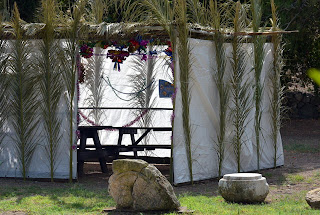


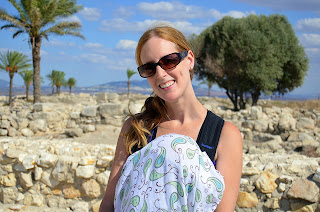


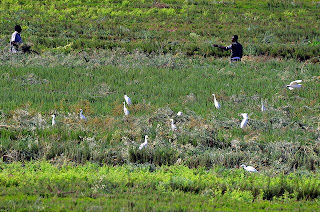



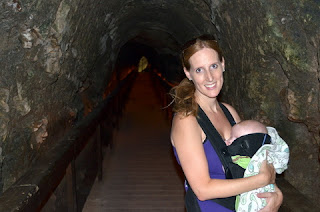
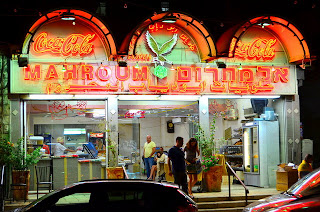



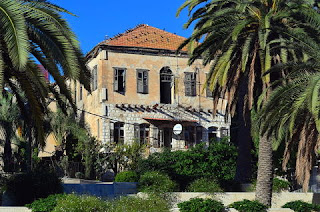
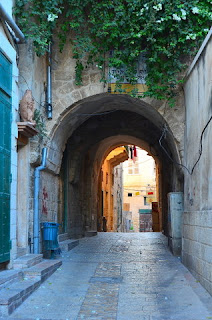


No comments:
Post a Comment